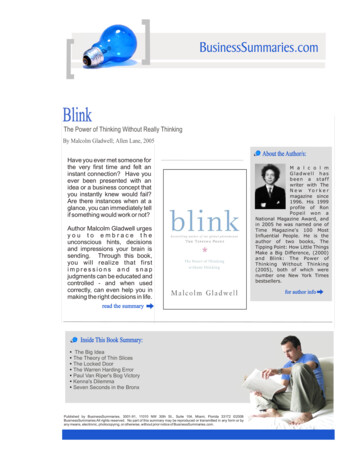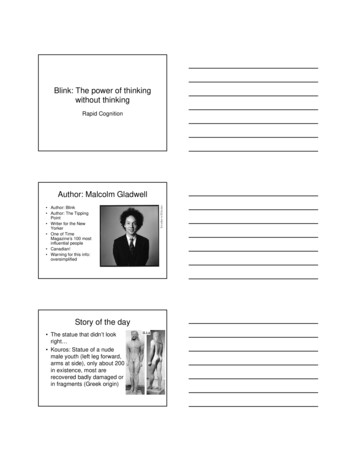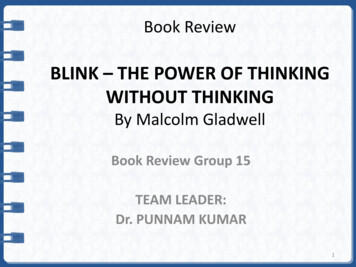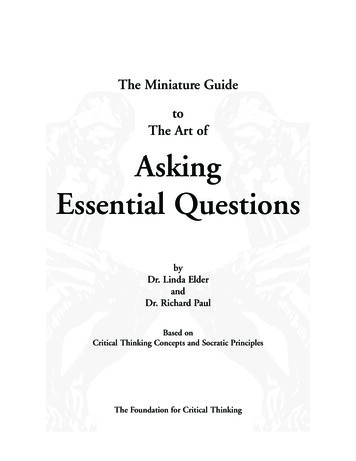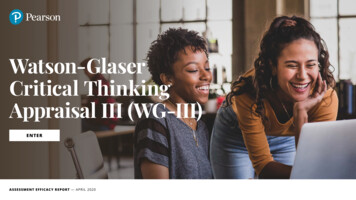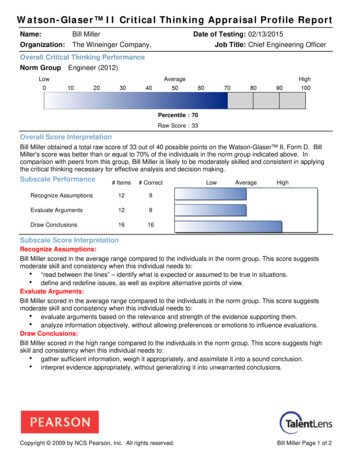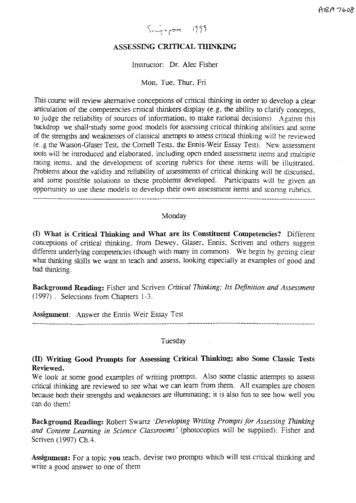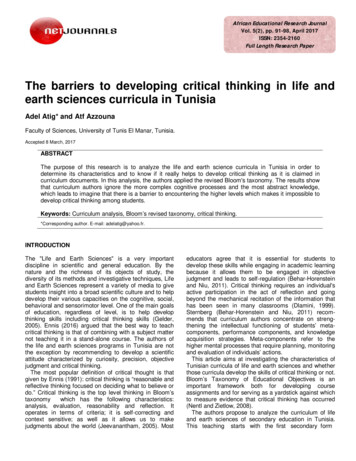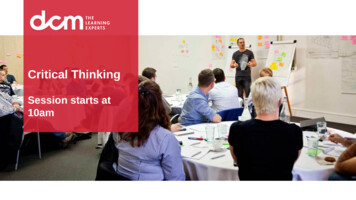
Transcription
Critical ThinkingSession starts at10am
HELLO!I am Karen MaherI am an experienced HR consultant andworkforce development specialist originally fromthe North East of England.I specialise in coaching, mentoring, mediation aswell as training design and delivery. I am alsoqualified to administer and deliver psychometrictests including EQi2 (Emotional Intelligence) andMBTI (Personality Types).
Content What is critical thinking?Barriers to critical thinkingOvercoming barriers to critical thinkingIdentifying your style3 rules for making stronger decisionsTips for evaluating riskIdentifying a problem and its root causeUsing visual tools which address any questionsConsider the challenge from different perspectives
What is Critical Thinking?Socrates advocated"seeking evidence, closely examiningreasoning and assumptions, analyzingbasic concepts, and tracing outimplications not only of what is said butof what is done as well."[Chiarini, Andrea; Found, Pauline; Rich, Nicholas (2015). Understanding the Lean Enterprise: Strategies,Methodologies, and Principles for a More Responsive Organization. Cham: Springer. p. 132.
What is Critical Thinking?Critical thinking is the process of careful,systematic analyse of problems to findviable solutions.It involves identifying several possiblesolutions and then logically evaluatingeach one, comparing them to oneanother on their merits, and thenselecting the most promising.
What is Critical Thinking?It is a broad skill that can be applied inmany different situations.Everyone thinks constantly but it isdifficult to think critically all the timeIt is an intentional process to usewhen we have problems or decisionsto make
What is Critical Thinking?Deliberately analysing information tomake better judgements and decisionsusing:
Barriers to Critical Thinking Egocentric Thinking Social Conditioning Biased Experiences Arrogance and Intolerance Schedule Pressures Group Think The Drone Mentality
Barriers to Critical ThinkingEgocentric ThinkingEgocentric thinking is viewing everything in relation to oneself.It is difficult for many people to identify this characteristic withinthemselves.The egocentric person is usually unaware of his or her thinkingpatterns.There are many successful people who are egocentric thinkers. They areclosed minded to the thoughts and ideas of others. This damages theircritical thinking abilities.Open minded thinking is one of the fundamental critical thinking skills.
Barriers to Critical ThinkingSocial ConditioningEach of us is unique. Age, IQ, race, genes, gender, culture, family, friends,and other factors effect on how we view the world.Critical thinking is hindered when people are viewed from biasedconditioning without learning the needs, and desires of others.Open minded critical thinking can enable you to listen, learn andempathise.Critical thinkers try to understand their own biases to help clarify thinkinghelp guide them towards conclusions that are rational, unbiased, logicaland fair
Barriers to Critical ThinkingBiased ExperiencesBiased experiences are a relative of egocentric thinking. Althoughexperience is a wonderful teacher, if it is filtered through a biased ordistorted view, that is how it is remembered.Think of your last bad customer experience – what happened, howdid this affect you?Critical thinkers create an open mind and ask themselves the question,“Am I thinking logically and rationally?”
Barriers to Critical ThinkingArrogance and IntoleranceArrogance and intolerance should be recognised for what they areand kept to a minimum.“When I was a boy of 14, my father was soignorant I could hardly stand to have the oldman around. But when I got to be 21, I wasastonished at how much the old man hadlearned in seven years.”Mark Twain
Barriers to Critical ThinkingTime PressuresTime pressures can be an enemy of critical thinking. They can lead to: Cutting corners - leading to mistakes and poor decision making. Undue stress - leading to mistakes and bad decision making. Procrastination - from not knowing how or where to start.This can lead to even more stress and cutting corners. A vicious circle begins.Think of a time when you had some excessive pressures from tight deadlines. Were any mistakes made? Did it cost time, energy and money to fix ? If more focused time had been invested up front to do the task correctly, would theresults have been better?
Barriers to Critical ThinkingGroup ThinkThere are three reasons it can be difficult to escape this mentality.1. The group think mentality is present every day. Radio, televisionand the Internet all reflect the current so called norm of thinking.Opinions are stated as fact by self-proclaimed experts. Unfortunately,many people don’t question what they hear, nor do they question thesource of information before repeating it.2. The problems of the world are complex. For the non-critical thinkerthe world is a much simpler place to live.3. The drive for acceptance from others is a strong motivating factor.Thinking outside the group can be uncomfortable.“When everyone thinks alike, no one thinks very much.”
Barriers to Critical ThinkingThe Drone MentalityThe drone mentality is a pattern of not paying attention to the world, people orsurroundings.Symptoms include: working through daily tasks without thinking, shying away from new challenges or problems.Without a conscious effort it is easy to loose critical thinking skills. There are someserious problems to not paying attention to what goes on. Being on automatic pilotcan cost dearly.Ask yourself : Does this make sense? If so, why? If not, why not?
Overcoming BarriersTo avoid the critical thinking barriers become awareof them, then make a conscious effort to avoid them.Critical thinkers continually question their thinkingand ideas as well as the thinking and ideas of others.Any other ideas to help overcome barriers to criticalthinking?
Your Critical Thinking StyleTeams are usually put together based on ‘doing roles’– their experiences, skills and competenciesBut another aspect to consider is aligning how they thinkWhat’s the focus of their thinking? ideas, processes, relationships, actionWhat is the orientation of their thinking? strategic, operational, big picture or details
Your Critical Thinking StyleBonchek and Steele (2015) “What Kind Of Thinker Are You?
Your Critical Thinking Style Which style(s) do you favour most? Which styles are present in your team? Which styles do you think are missing? Which style is most prevalent in your organisation?When you know your thinking style, you know what energisesyou, why certain types of problems are challenging or boring, andwhat you can do to improve in areas that are important toreaching your goals.
Your Critical Thinking StyleBIG PICTUREDETAIL Explorer thinking is about generatingcreative ideas. Expert thinking is about achievingobjectivity and insight. Planner thinking is about designingeffective systems. Optimizer thinking is about improvingproductivity and efficiency. Energizer thinking is about mobilizingpeople into action. Producer thinking is about achievingcompletion and momentum. Connector thinking is about building andstrengthening relationships. Coach thinking is about cultivating peopleand potential.
Basic Rules for Making Decisions1. Be less certain – don’t be overly confident about each step of thedecision making process. Once you accept that you’re overconfident, youcan revisit the logic of your decision2. Ask “how often does this happen?” - This rule, known as the base rate,comes up a lot in the research on prediction, but it can be helpful for thejudgment side of decision making too.3. Use basic probability - Improving your ability here will help you with thefirst two rules. You’ll be able to better express your uncertainty and tonumerically think about “How often does this usually happen?”The three rules together are more powerful than any of them alone.
Evaluating RiskEvaluating risk is an essential critical thinking skill.For example – the introduction of new legislationOrganisations must assess the potential impacts of new legislation on the waythey work and how the new law will affect their clients.This requires critical thinking skills such as analysis, creativity (imagining differentscenarios arising from the legislation) and problem-solving (finding a way towork with the new legislation).What happened in your organisation when GPDR was introduced in 2018?
Identifying a problem1.2.3.4.5.6.Defining the problem.Determining the reasons for the problem.Determining the underlying conditions that giverise to the reasons for the problem.Designing a solution.Implementing the solution.Evaluating the success of your solution
Identifying a problem– Some tools The Five WhysMind MappingBrainstormingFishbone diagramPareto Analysis
Using Visual ThinkingVisual thinking can help organise our ideas, and see connections we haven’tseen before. Even when we think that we have everything perfectly reasonedlogically in our heads, visual thinking can be an important last step to seeingall the possibilities, and not to focus blindly on the most obvious. Post sing visual thinking in the workplace can help to organise informationbetter, and stimulate creativity.
Different PerspectivesBe inclusiveConsider other perspectives that are different from your own. When comparingopposing perspectives, we may discover similarities.Be interactiveStudies have shown empathy does not come about by just imagining what theperson is going through. We need to interact with the person by asking andlistening to find out their concerns and circumstances.Balance subjectivity and objectivityTo empathise with another person's perspective involves emotions andsubjectivity. But empathy must be accompanied by some detachment to maintainobjectivity in evaluating issues and perspectives. Detachment means the abilityto step back to see the bigger picture,
Summary What is critical thinking?Barriers to critical thinkingOvercoming those barriersIdentifying your styleMaking stronger decisionsEvaluating riskIdentifying a problem- some toolsUsing visual toolsDifferent perspectives
Summary & RecapQ&A
GOOD BYE &GOOD LUCK!
Barriers to Critical Thinking Time Pressures Time pressures can be an enemy of critical thinking. They can lead to: Cutting corners - leading to mistakes and poor decision making. Undue stress - leading to mistakes and bad decision making. Procrastination - from not knowing how or where to start.
